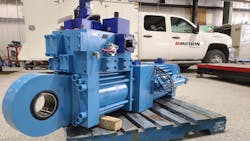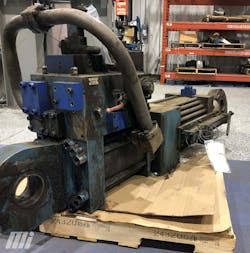At a Glance:
- PID stands for proportional-integral-derivative, the types of control methodology used by the system setpoint to correct errors in real time.
- Implementing PID control into hydraulic systems has resulted in unique technologies and equipment designs. Consider, for example, the controllability of a fighter jet and its ability to turn on a dime mid-flight.
- A PID controller’s goal is to correct the error between a system’s setpoint and its output.
- Loosely described, PID functions as the present (proportional), past (integral) and future (derivative) means of controlling and correcting error for a given system.
The advent of affordable PID controllers has been a game-changer throughout most industries. This is just as true in many of our everyday devices—anyone who has ever set their vehicle’s cruise control while driving to work can thank this control methodology for not getting a speeding ticket. As computer processors become ever faster and more economical, new and exciting uses for this technology are starting to be seen everywhere—from the Segways that first captured consumers’ imaginations to the hoverboards that children now zip around on.
To start, it is important to understand the acronym PID. It stands for proportional-integral-derivative, the types of control methodology used by the system setpoint to correct errors in real-time. You might see P, PI, PD or PID referenced with the controller for a given system—these indicate what controls are or are not being applied.
At this point, you will most likely be drawing parallels between the terms above and your old math classes. You would be right to do so, in the same way you calculated slope, rate of change or the area under the curve. A PID controller’s goal is to correct the error between a system’s setpoint and its output.
Before discussing the individual components of a PID controller, let’s first define a system. It is anything where a command, setpoint or target is issued and a device, circuit board, program or piece of equipment is expected to react to that signal by matching it with the system’s output.
The analogy that my controls professor always liked to use was balancing a stick on your finger. This helped explain the concepts of systems and controllability in an easy and intuitive real-world example. For this system, you have several components: your arm and hand that act as an actuator (the part doing mechanical work), your eyes as the feedback sensor and your brain as the controller. The system output is the stick’s position in three-dimensional space. The goal or setpoint of this system is to balance the stick.
You may have, at some point in your life, participated in this activity. However, few of you have probably reflected on how easily your brain can intuitively apply a PID control to maintain the stick’s position in real time. As your eyes monitor that position, your brain will perform a calculation and issue commands to your arm/hand to keep the desired setpoint while correcting for the error. You could easily draw parallels to a servo system for cylinder positioning, hydraulic motor speed or even a pressure-control application.
When we discuss a system’s controllability, it refers to the ease of controlling the function and thus the level of design complexity required for the equipment being constructed. If we extend our stick analogy, you could easily understand that a longer stick is inherently easier to control. Most people can balance a yardstick on their finger, but only a few could do the same with a pen. Further, possibly just one of those few could maintain tight control of pen movement. In this system, the controllability is directly linked to the length of the stick/pen.
This level of system controllability is important to understand for a given application if you intend to design an effective and cost-efficient PID control. This controllability will determine the equipment’s complexity required. Some systems will not be controllable at all. When designing PID control for a system, determining if it is controllable should be your first step. The behavior of any system will be defined by the differential equations that govern that system (a topic unto itself). However, speed/positioning and pressure regulation for fluid power systems are typically controllable.
When discussing the individual components of a PID controller, proportional control is usually a good starting point. Whether implementing a P, PI, PD or PID control, proportional control will always be a major component—but this is not true for integral or derivative. In reference to these controls, you will also hear of the gains: Kp, Ki and Kd. These gains allow you to scale/ change the degree of influence that each control type will have.
For example, if you institute a PI controller, you set Kd to zero. Adjusting these gains is how systems are tuned during commissioning. This process can be time-consuming because you often have to make small incremental changes. Changing one gain has an impact on the others, which can make tuning a challenge.
Proportional control is scaled directly proportional to an existing error between the setpoint and a system’s output. This means that when an error is large, the reaction to that error is large; when the error is small, the reaction is small. A good visualization would be an ideal spring anchored on one end, with the other connected to a movable load in space (or anywhere without gravity). In its resting state, assume that position to be the setpoint. If the load is disturbed, the spring will be either compressed or stretched relative to the disturbance. The spring will immediately work to correct for the disturbance. If compressed, the spring will push against the compression; if stretched, it will likewise resist and apply an opposite force.
After the disturbance is removed, the spring will return to its steady-state position. In this analogy, the “proportional gain” is the spring’s strength. The stronger it is, the quicker and more forcefully it returns to its steady-state position, but the more susceptible it is to oscillating over time. With a higher gain, it will move towards the target more aggressively—but it is also more likely to overshoot.
Integral control, much like integration from your old calculus class, can be best thought of as fancy addition. The integral component accumulates the error over time between a setpoint and output of a system: As the target approaches the setpoint, the value will increase, and if the target overshoots the setpoint, the value will decrease. Over time, this value will reach an equilibrium and the system will stabilize. An overly aggressive integral gain will make the system susceptible to “integral windup” (overshooting the target). In a cylinder positioning system, this integral windup would appear as the cylinder slightly overshooting the target and then come to rest in position.
Derivative control is used to counteract the change rate of an error. This is most effective against sudden disturbances as it works to resist change and quickly correct for the disturbance. This does, however, mean the derivative control can be susceptible to noise or error from things like the sensor limitations or the signal discretization in processors. Also, if there is no disturbance in the error (i.e., it is steady but off by a defined value), the derivative control will not help correct for that error. When tuning derivative gain, be very careful: Make small changes and start at a low value. Adding too much derivative gain or having noise in the system can lead to violent reactions for some systems.
Pulling it all together, you can loosely describe PID functions as present (proportional), past (integral) and future (derivative) means of controlling and correcting error for a given system. The proportional control focuses on correcting for something as it happens, integral control corrects for past error over time, and derivative control corrects for disturbances and their predictive impact. Now, this isn’t to say that it predicts the future, but by reacting to the rate of change, it can take “predictive-like” corrective action.
Implementing PID control into hydraulic systems has resulted in unique technologies and equipment designs. When envisioning the possibilities, it is important to keep an open mind. The degree of system controllability is particularly interesting. At face value, a more controllable system often seems positive, but for the quickest way to be dynamic and nimble, a less controllable system with a robust PID control might be an advantage for the task. A good example would be a fighter jet and its ability to turn on a dime mid-flight.
Be receptive and get creative as emerging technologies from adjacent industries quickly spill into the fluid power industry. This enables newer and better ways to design equipment while blurring the lines between historically well-defined disciplines in the system design space. As time goes on and new technologies appear, the separation between mechanical, automation and fluid power system design will be less distinct.
Based out of Calgary, Ian Miller, P. Eng. is a national services business development manager for Motion. He has over a decade of hydraulic and electrical experience in the field, including system design, troubleshooting, on-site installations and technical training/support.
About the Author
Ian Miller
National Services Business Development Manager, Motion Industries Canada

Leaders relevant to this article:


